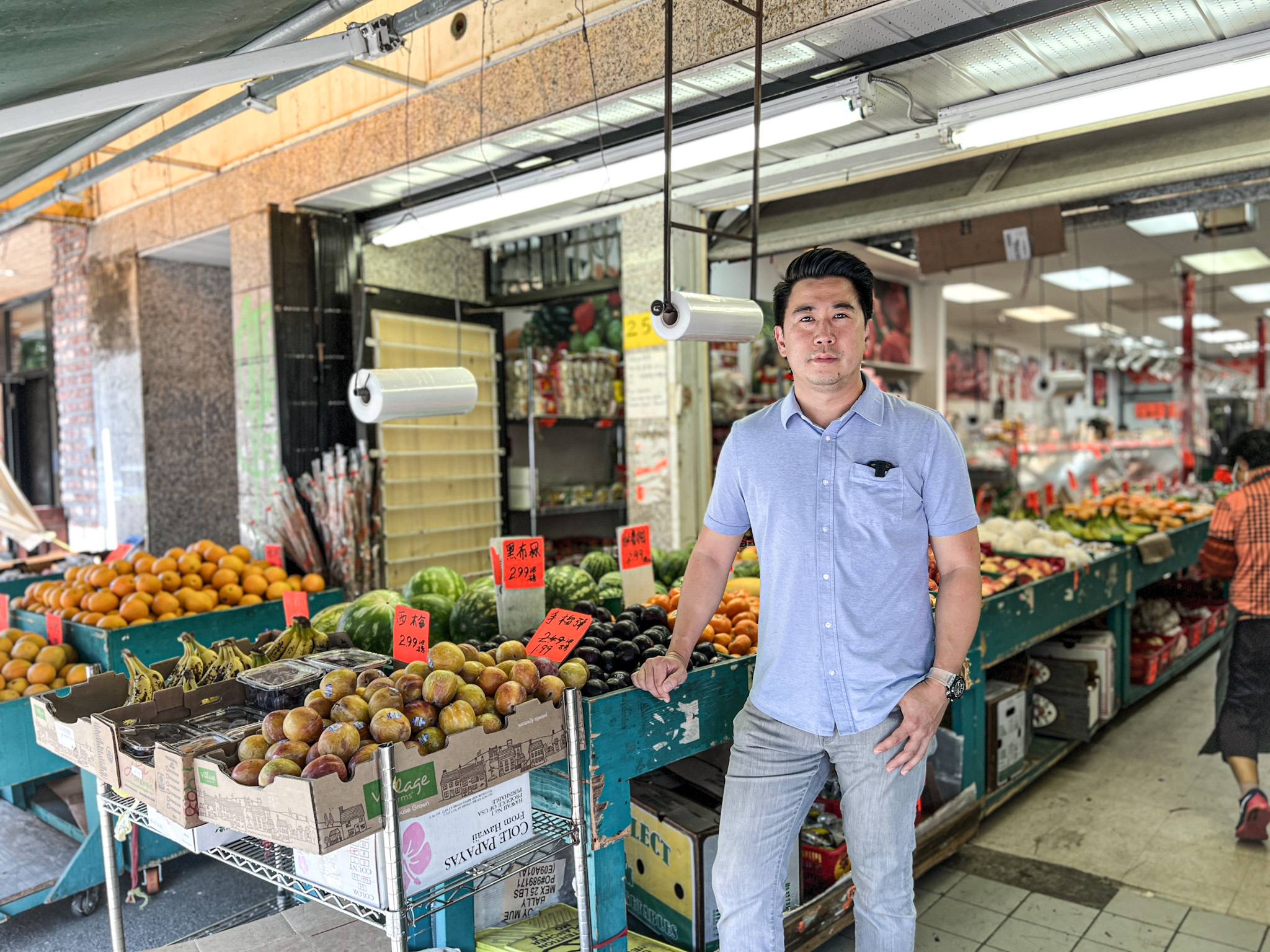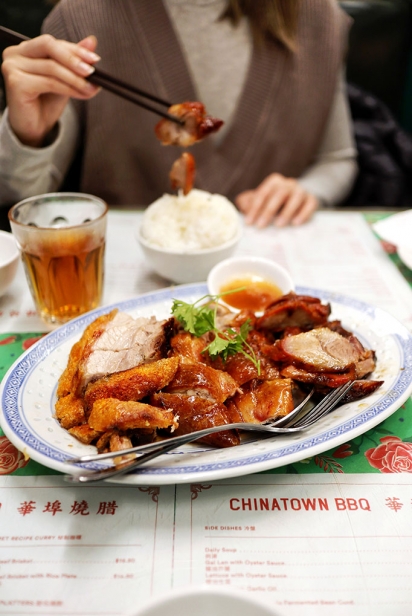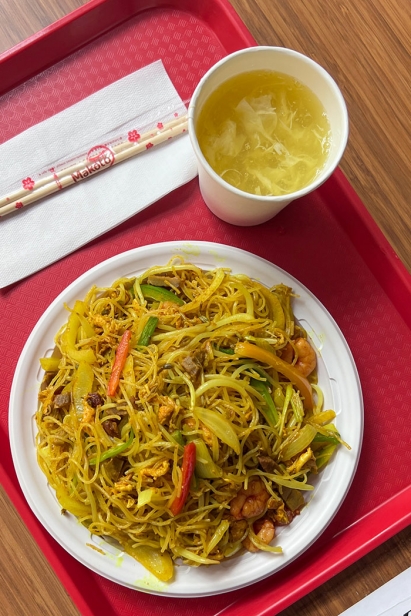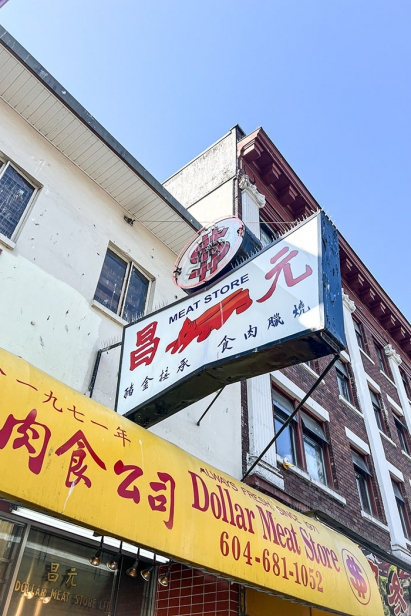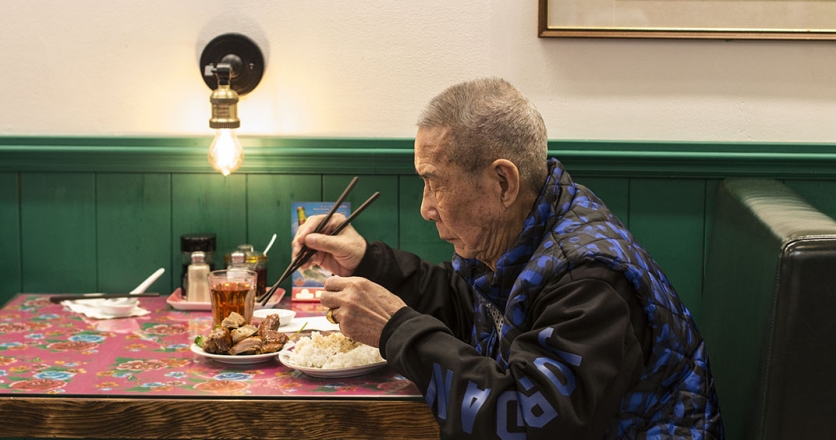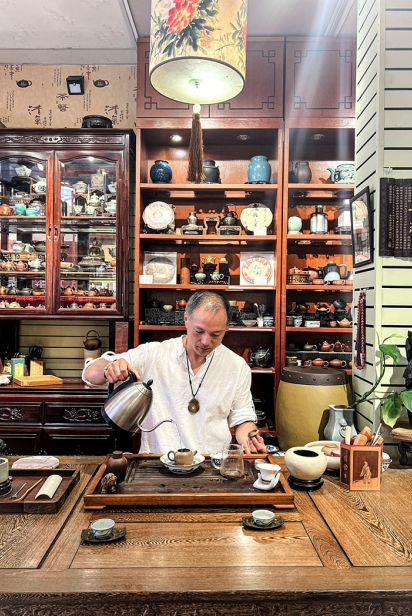Chinatown's Bountiful Banquet
In Vancouver’s Chinatown, gleaming red and gold dragons writhe on the lampposts and the fragrance of ginger, garlic and chilies fills the air. This historic community is as old as the city itself, a vibrant neighbourhood where locals and visitors alike come to shop and to celebrate, to eat dim sum and BBQ duck and flaky pastries, to sip tea and sometimes to enjoy something a little stronger.
Chinatown has ever been in a state of change. But in the years before COVID, that change was moving so fast, Chinatown was in danger of disappearing entirely.
“It was a gradual change and then a quick change, where I’d go, ‘What happened here?’” says William Liu, whose family has owned Kam Wai Dim Sum since 1991. He had never seen so many people moving out of the neighbourhood he had grown up in, or so many businesses shuttered, or so many new buildings replacing the old. “It was very, very sad,” he says.
And then, COVID hit. As pandemic restrictions kept businesses closed and customers at home, Chinatown’s proximity to the Downtown Eastside and nearby tent cities brought new problems. Street disorder increased. Residents, especially seniors, became more and more fearful. Visitors were reluctant to park or walk here, especially after dark.
But that was then. Now Chinatown is on the rebound, thanks to a community passionate about preserving its past and investing in the future.
“To me, Chinatown was always about welcoming people from all backgrounds and all walks of life,” says Carol Lee, chair and co-founder of Vancouver Chinatown Foundation. “I want to bring that culture back.”
And at the heart of that culture is, as always, food and drink.
A neighbourhood illuminated
Officially, Vancouver’s Chinatown begins at the alley between Hastings and Pender Streets and ends at Georgia Street to the south, embraced by Taylor Street in the west and Gore Avenue to the east. It’s just a few blocks in size, but is filled with an abundance of places to eat.
So it’s not surprising that food has been a centrepiece at Light Up Chinatown! The second annual two-day celebration of community was just held in September and, along with the live entertainment and colourful decorations, featured a walking food tour, food trucks, special menu items and a collaboration between the Chinese Restaurant Awards and Vancouver Chinatown Foundation (see sidebar), all designed to remind everyone what a delicious dining destination Chinatown is, and always has been.
Lee, who is co-founder of the festival as well as the owner of Chinatown BBQ, even collaborated with Beaucoup Bakery’s Betty Hung on the Original Peking Duck Croissant: shredded roasted duck, hoisin sauce, scallions and five spice powder tucked in a classic butter croissant.
The festival is just one of the Vancouver Chinatown Foundation’s many projects. There is also the Storytelling Centre and a social housing project at 58 West Hastings Street that will provide 230 new homes and a 50,000-square-foot integrated health centre for the Downtown Eastside.
“We are trying to do our part,” Lee says. She notes that the challenges in the neighbourhood — people camping in doorways, broken windows, open drug use, attacks on Chinese seniors — have been well publicized, but adds, “It’s not just Chinatown, it’s everywhere. Mental health is an issue everywhere.”
But Chinatown also bears the weight of a history formed by racism. It only exists in the first place because Chinese people weren’t allowed to purchase property in other parts of town or even frequent businesses there.
So Chinese immigrants created their own flourishing community, which was, at times, the target of thugs like the Asiatic Exclusion League as well as politicians and developers with an eye on its valuable real estate. In the 1960s, for instance, the city appropriated dozens of blocks of housing in Chinatown and neighbouring Strathcona to build new projects, culminating in 1971 with the destruction of Hogan’s Alley, home to the city’s small but vibrant Black community, to build the Georgia Viaduct.
But Chinatown has always been resilient. In the 1980s, a new wave of immigrants, mostly from Hong Kong, encouraged the installation of bilingual street signs and the red lampposts adorned with golden dragons, as well as the Dr. Sun Yat-Sen Classical Chinese Garden and the Chinese arch in front of the Chinese Cultural Centre.
Now the community is determined to bounce back from the triple whammy of the opioid epidemic, the housing crunch and COVID. “Chinatown was already struggling before COVID. We really needed to do something to bring people back to the neighbourhood,” Lee says.
The result? The foundation, the festival and all the new projects.
“I think there’s lots of good stuff happening.,” she says. “It feels like we’re all working toward a common goal. I’m happy with how our community has come together and a lot of people are big supporters of the neighbourhood. There are always bright spots.”
A community hub
The brightest spot, of course, is always the food. Not so long ago, Chinatown was chock-a-block with bakeries and cafés, banquet rooms and dim sum parlours. Steamy windows were filled with pork buns, egg tarts, dried sausages and glistening, mahogany-hued BBQ ducks. Customers on their way to the Ho Restaurant or Daisy Garden Kitchen navigated sidewalks busy with people speaking myriad languages, dodging bins and baskets overflowing with dried fish, ginseng, spices and herbs, as well as bitter melons, bok choy, foot-long beans and other fresh produce.
William Liu remembers those days. Back in the 1980s, before they opened the dim sum shop, his family owned a bakery café on Keefer Street and lived in nearby Strathcona. “It was easy for me to come home from school and visit my mom at work,” he recalls. “She would get me to make wontons — I’ve been very much hands-on in the business for a long time.”
As newcomers arrived from Hong Kong in the years leading up to the 1997 handover to China, Liu’s dad had an idea for a new business, and Kam Wai Dim Sum was born. “We specialize in frozen dim sum because we saw a need for it with all the immigration from southern China and Hong Kong,” Liu says. “It was a really easy meal solution for people immigrating from China and working 12, 14 hours a day. They could just come home and throw something in the steamer.”
In addition to the frozen siu mai and har gow, the business also sells hot, ready-to-eat steamed bao, rice bowls and dumplings to go. “We’re very well known for our sticky rice wrap — and it’s actually a dying art because it’s a very difficult technique,” Lui says. “We make about 200,000 of these a year. It’s kind of insane.”
But the business is about more than the food it sells. It is also a community hub.
Lui recently renovated his storefront (with the help of a grant from Strathcona BIA) to modernize it and make it more accessible. Because 65 per cent of his business is wholesale, he can sell the retail products at a price accessible to people on tight budgets. He also strives to educate his customers about the food they are eating, not only providing full ingredient lists, but also offering transliteration so they can pronounce what they are ordering.
“Our business, we’ve been around a long time. We serve the community at large. We’re here for the Chinese community, but we’re also here for the people on the Downtown Eastside,” he says. “We’re bringing in a newer clientele who never knew we existed before, even though we’ve been here 30 years. People come to Chinatown specifically for us.”
And Liu himself participates in community experiences like the Chinatown opera composed by Alice Ping Yee Ho with a libretto by Madeleine Thien, which recently debuted at the Vancouver Playhouse. Liu had been an opera student at the University of British Columbia, but when his father got sick, he took over the family business instead of pursuing a career in the arts. He’s never regretted it. “Arts is fulfilling, it’s something that feeds my soul, but family is important to me,” he says.
A banquet of global flavours
In recent years, the Chinese population of Chinatown has plummeted. According to figures from the Vancouver Chinatown Business Improvement Area, only 21 per cent of people living in Chinatown report Chinese heritage, compared to 29 per cent in the rest of Vancouver. Many of the original Chinese families have left for suburbs like Richmond and Burnaby, making this a community of singles, often young, low-income, male and Indigenous, Black or Southeast Asian.
At the same time, changes to zoning laws have made it easier for developers to replace old buildings with new, which explains all those featureless condo blocks going in along Main Street. They’re a far cry from the colourful architecture of a community that, in its 1920s heyday, boasted two Chinese theatres, six schools, a hospital, a library and a large number of association buildings, as well as non-Chinese institutions such as City Hall and Vancouver Public Library.
As the families have left and older buildings have been lost, many of the traditional Chinese bakeries, cafés and restaurants have closed. But other establishments have opened in their place, attracted by the community’s heritage charm as well as its relatively affordable rents.
Some of the city’s most exciting cocktail bars are here, including The Keefer Bar, Laowai and Chickadee Room. (Of course, Chinatown was always a good place for a drink — even when the rest of the city went dry during Prohibition, you could always find a pot of “cold tea,” also known as whisky, here.)
Many of Vancouver’s favourite chefs and restaurateurs have found a home in Chinatown. Sean Heather moved The Irish Heather Shebeen here from Gastown in 2021. Over on East Pender Street, there’s Kissa Tanto, chef Joël Watanabe’s terrific Japanese-Italian fusion joint. On Union Street, chef Andrea Carlson has her neighbourhood grocery/eatery Harvest Community Foods and natural wine-focused Bar Gobo, while on East Georgia, chef Angus An is dishing up noodle soups at Fat Mao.
There are new Asian restaurants, too, often with a Southeast Asian or fusion focus. Among them: the Vietnamese DD Mau Eatery, modern Chinese brasserie Bao Bei, Asian fusion Sai Woo and pastry chef Andrew Han’s modern bakery, Kouign Café.
And some of the older Chinese places are still doing brisk business, including the 43-year-old Daisy Garden Kitchen, which recently reopened after a 2015 fire, as well as stalwarts like the Floata Seafood Restaurant, Ming Fong Fast Food in Chinatown Plaza, New Town Bakery & Restaurant with its world-famous steamed buns and Sun Fresh Bakery with its award-winning barbecue pork rice rolls.
Although she welcomes the newcomers, Lee insists it’s important to preserve the Chinese culture, too. “It won’t be very interesting if we don’t have any of it left,” she says.
“The historical places were multi-generational. People would bring their children and their grandparents,” she adds. “Chinatown was a place of celebration. People came down if it was a birthday or an anniversary or if there was something to celebrate.”
Opening Chinatown BBQ five years ago fulfilled her dreams of creating both a classic Cantonese barbecue and a community hub. Now she has her eyes on a local landmark — she’s resurrecting the legendary Ho Ho Restaurant, which closed in 2014, 60 years after it first opened. Even those who’ve never enjoyed its Chinese-Canadian fare and retro cocktails know the place, thanks to its famous 30-foot-high neon sign, erected in 1954 by the folks at the Wallace Neon shop.
“I cry every time I hear somebody say, ‘I’ve been waiting for you to open it,’” Lee says. “It’s another place I consider a community hub. It was almost like the Cheers bar, a place where everybody knows your name.”
When it re-opens, most likely in February, the Ho Ho will serve elevated Chinese-Canadian cuisine and mid-century cocktails. Craig Stanghetta’s Ste. Marie Studio is designing the space, with an eye to capturing its mid-century esthetic in a whole new way. “It’s going to be amazing. I’m redoing that sign, that 30- foot sign,” Lee says. “This is an important part of the Vancouver community. This is a really great story for Vancouver.”
When that sign lights up, it will signal the return of one of the city’s most vibrant, and welcoming neighbourhoods, a place where everyone of all ages and backgrounds can hang out and enjoy something delicious to eat while they do.
“This is how you revitalize a community,” Lee says. “It’s the people. It’s not the buildings.”
A taste of Chinatown
During the recent Light Up Chinatown! Festival, the Chinese Restaurant Awards and Vancouver Chinatown Foundation co-announced the Five Chinatown Legends and Critics’ Choice Top 10 Dishes, in celebration of the community’s finest cuisine. But any time is a good time to taste what these establishments are cooking up.
Five Chinatown legends
In the spirit of new school honouring the old school, celebrated chefs Angus An of Maenam and Fat Mao, Roger Ma of Boulevard Kitchen & Oyster Bar and Andrew Han of Kouign Café, as well as Douglas Chang of Ai & Om Knives and Sean Heather of The Irish Heather Shebeen recognized the following businesses and people as being key to making Chinatown what it is.
-
Cindy So, staff of Carley BBQ & Hotpot Supplies
Daniel Lui, owner of The Chinese Tea Shop
Jimmy Chiong, owner of Gar-Lock Seafood
Joey Wong, owner of Dollar Meat Store
Smitty Ho, staff of Maxim’s Bakery-
2022 critics’ choice top 10 dishes
Selected by a judging committee chaired by food writer Lee Man, these dishes feature both traditional favourites and modern creations, reminding diners why Chinatown is such a must-visit foodie destination.
-
BBQ Duck with Noodle in Soup, Chinatown BBQ
Butter Beef, Phnom Penh Restaurant
Bún Chả Hà Nội, DD Mau Chinatown
Century Egg with House Tofu, Fat Mao Noodles
Curry Beef Brisket on Rice, Daisy Garden Kitchen
Singapore Fried Noodles, Ming Fong Fast Food
Steamed BBQ Pork Rice Rolls, Sun Fresh Bakery
Steamed Dai Bao, New Town Bakery & Restaurant
White Rabbit cookie, Kouign Café
Tajarin (butter, roasted mushrooms, miso cured yolk), Kissa Tanto
-
-
Visit chinatownfoundation.org for more on the Vancouver Chinatown Foundation and Light Up Chinatown!
-


